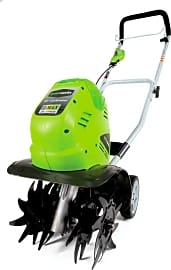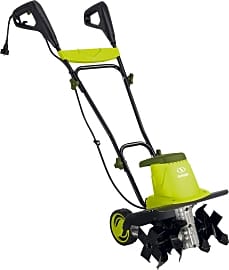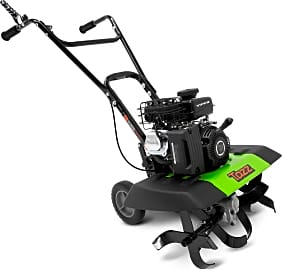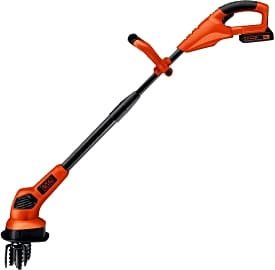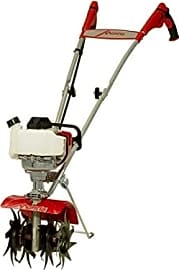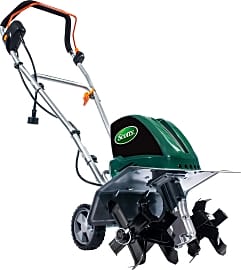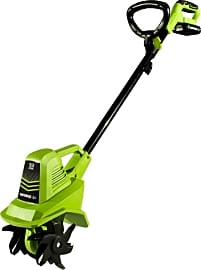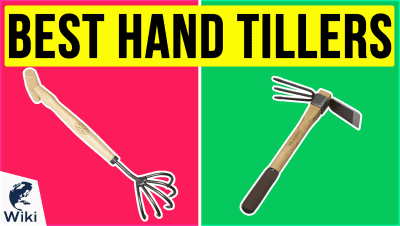The 10 Best Tillers

This wiki has been updated 41 times since it was first published in March of 2015. Whether you're prepping your garden for a new flower bed, planting vegetables, or maintaining an existing plot during the growing season, one of these rototillers can help optimize and tame the land with minimal fanfare. We've included both electric and gas-powered cultivators with durable tines suitable for aerating and loosening soil or breaking through highly compacted areas. When users buy our independently chosen editorial selections, we may earn commissions to help fund the Wiki.
Editor's Notes
September 30, 2020:
I believe that including a mix of electric and gas-powered models provides a well-rounded representation of this type of outdoor power tool. Not all yards and properties are created equal, so it's important for us to ensure that our options reflect that understanding. For some users, a gasoline engine will deliver the power necessary to pulverize unbroken soil, which comes in particularly handy when tilling large areas of land for the first time. On the other hand, an electric tiller can eliminate the messes often associated with oil and gas. If you're only dealing with small seedbeds and/or narrow rows of plantings, using a battery-operated model would certainly make sense, as less power is needed to get the job done and such a device would be easier to maneuver into tight spaces.
This year, we've removed the YardMax YT5328 and YT4565 models, Southland SRTT212, and Craftsman 12-Inch due to availability issues.
Newly added is the quiet and efficient Greenworks Cordless, which utilizes a gear drive transmission to power through extremely tough and compacted soil.
We've also included the Tazz 2-in-1 for its low center of gravity, wide range of width adjustments, and smooth recoil start.
Ideal for small plant beds, the counter-oscillating tines on the Black & Decker LGC120 prevent weed tangling, while its telescoping shaft makes it relatively easy to handle.
Although the Agri-Fab Tow Behind is quite expensive, its shock-absorbing pin hitch supports easy connections with ATVs and lawn tractors, while the forward-rotating blades make it well suited for prepping seedbeds on large plots of land.
April 20, 2019:
There are 3 kinds of tillers: front tine, rear tine, and cultivators. Cultivators are built for light-duty use such as turning over soil in raised beds or ripping up stubborn weeds. The EarthWise 7.5-inch is just about most compact and lightest, and while it's not meant to eliminate large rocks, it does well at what it's intended for. The SunJoe is another good electric cultivator, while the larger Earthwise is on the border between cultivators and front-tine tillers. The Mantis is a decent gas-powered model, while the Craftsman is one of the more reliable and powerful light-duty units.
Concerning front-tine models, the Earthquake Versa is actually a convertible and can serve as a light-or medium-duty unit. The smaller YardMax is a fantastic front-tine model as well, as it's both powerful and maneuverable. But the Champion is one of the best-made models on the market, and if it isn't sufficient for your needs, you'll have to move up to a rear-tine model.
The Southland is a very strong unit and worth a look if you need to break through exceptionally dense ground. The bigger YardMax can power through just about anything, though, so if you're dealing with rocky land and thick roots, it's a great choice. Considering its strength and ease of use, it's actually a fantastic deal.
Special Honors
Barreto 1320H Ideal for tilling large areas, the full-size and expensive Barreto 1320H features independently running transport wheels and tines. While its wheels can travel at variable speeds, the engine and blades will maintain a consistent velocity. Additionally, the blades will stop automatically when the wheels run in reverse. This one also has an integrated dirt shield to prevent wire, string, and other objects from damaging the hydraulic motor seal. barretomfg.com
Why Gardeners Use Tillers
This will help ensure that your garden soil has a high amount of nutrients without any areas containing too much fertilizer and affecting blooms and vegetable growth.
A tiller is a garden tool that is used to loosen up soil before initial and in-between seasonal plantings. It can also be used to rip up weeds between rows of raised garden beds and aerate soil for better drainage. Tillers are also a great way to prepare a new, previously unused area for gardening.
A tiller's main purpose is to simplify the typically laborious and time-consuming process of ripping up weeds and turning soil. By using a tiller, one can eliminate the need for hoeing and manual soil turning. This is doubly true if you have a large garden area to prepare. Tillers can rip through roots and large clumps of dirt, ensuring that weeds are completely destroyed while also reducing the need for chemical weed killers.
Tilling weeds is better than ripping them out, as it leaves the organic plant matter in the soil, so it can decompose and fertilize your garden. For those living in areas with hard-packed soil, a tiller is a useful garden companion because its tines can dig deep into the ground, leaving it light, fluffy, and ready for planting when the job is complete.
A tiller can also be a great way to evenly distribute fertilizers or compost throughout the soil before planting. This will help ensure that your garden soil has a high amount of nutrients without any areas containing too much fertilizer and affecting blooms and vegetable growth.
How To Use A Tiller
Before starting to till, you must clear the area of any large debris, like rocks or branches, which could potentially damage the tool's tines or cause injury if they fly into the air. If you plan on tilling an area with thick overgrowth, you should use a garden trimmer to hack it down to just a couple of inches or less above the ground. It is best to till dry dirt, as wet dirt has a tendency to clump after tilling.
The second tilling session should proceed more quickly than the first, as you can start immediately at a deep setting.
When the soil is hard and compact, start the tiller on a shallow setting. If you are dealing with softer soil, you can start with the tiller at a medium depth. Upon achieving the proper depth, engage the tines and slowly make parallel passes across your yard until you have covered the entire area at least once.
After tilling the garden area once, set the tool to a deeper setting and make a second pass over the area in the same pattern as previously used. Once finished, you can make a few perpendicular passes. Make sure you are walking slowly as you till the area and let the tiller do its job. Never try to force one forward.
Once you are able to easily till the garden bed at a depth of seven or eight inches, you are finished with the first tilling session. Wait a few days for the organic matter in the soil to break down and give any remaining weed seeds or live weeds a chance to sprout, then start the tilling process again. The second tilling session should proceed more quickly than the first, as you can start immediately at a deep setting. As with the first time, you should make one complete pass in a parallel orientation followed by a perpendicular pass.
How To Choose The Right Tiller For Your Needs
The majority of tillers are relatively heavy and take a strong hand to control. As you might expect, small tillers, sometimes called cultivators, are easier to control than full-sized tillers. They are also better suited for small gardens. Even if you have a large garden and feel that it warrants a full-sized tiller, but you are too small to control one, then you would still be better off with a mini tiller or cultivator.
The majority of tillers are relatively heavy and take a strong hand to control.
As a general rule of thumb, tillers and cultivators are recommended for gardens 300 square feet or greater. For any yards or gardens smaller than that, a hand tiller should be used. Gardens under 1,500 square feet can be tilled easily with a mini-tiller or cultivator. Those with gardens in the 2,000 to 5,000 square foot range will need a larger tiller with an engine between four and six horsepower. Any garden over 5,000 square feet calls for a large, almost industrial-sized tiller with an engine from seven horsepower and up.
If you live in an area with very hard or rocky soil, you may need a slightly stronger tiller, so even if you only have a 1,000-square foot garden or yard, it may be better to choose a medium-sized tiller with more power.
For smaller yards and gardens, consumers may be presented with both gas and electric models that seem suitable. Gas models will be noisier and more difficult to start, especially on cold days, but they are generally more powerful. Electric models are quiet and easily start at the push of a button.


